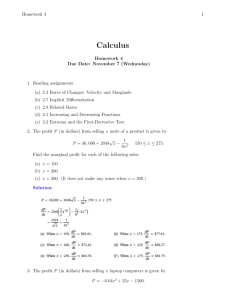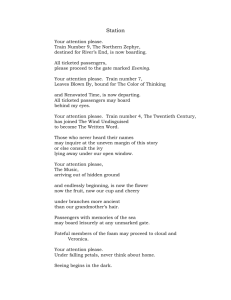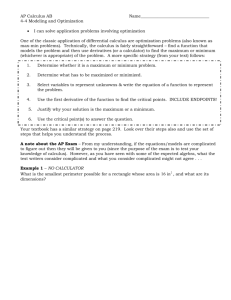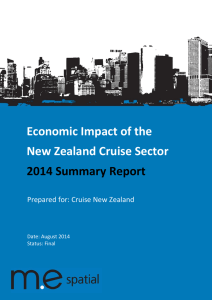Homework #9 Solutions
advertisement
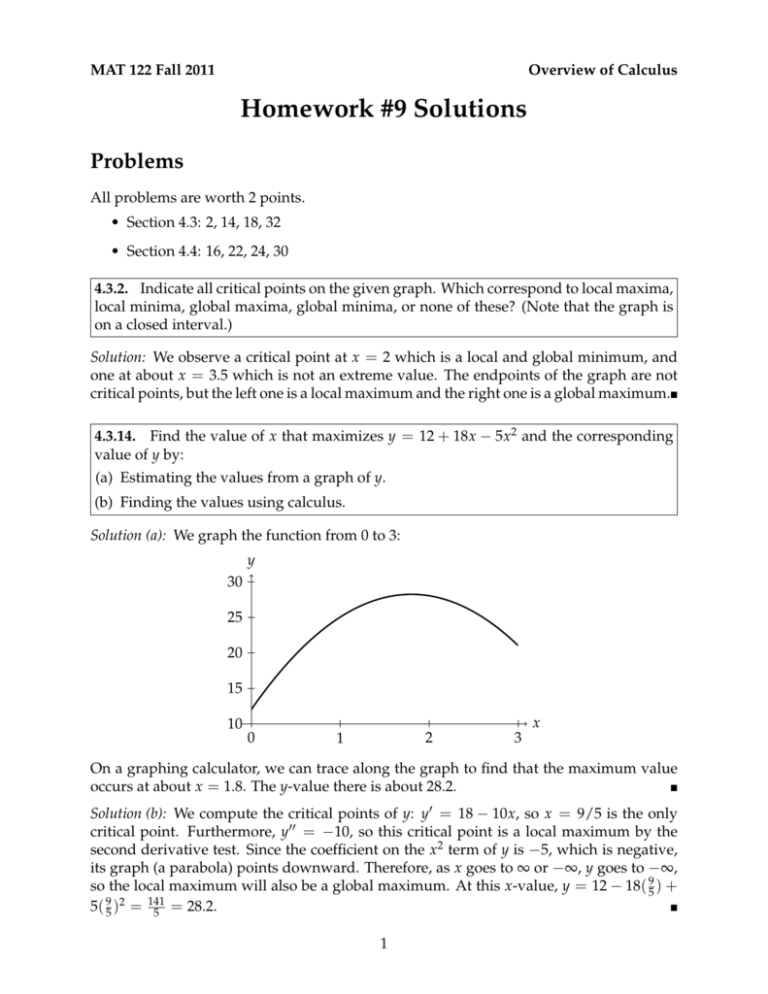
MAT 122 Fall 2011 Overview of Calculus Homework #9 Solutions Problems All problems are worth 2 points. • Section 4.3: 2, 14, 18, 32 • Section 4.4: 16, 22, 24, 30 4.3.2. Indicate all critical points on the given graph. Which correspond to local maxima, local minima, global maxima, global minima, or none of these? (Note that the graph is on a closed interval.) Solution: We observe a critical point at x = 2 which is a local and global minimum, and one at about x = 3.5 which is not an extreme value. The endpoints of the graph are not critical points, but the left one is a local maximum and the right one is a global maximum. 4.3.14. Find the value of x that maximizes y = 12 + 18x − 5x2 and the corresponding value of y by: (a) Estimating the values from a graph of y. (b) Finding the values using calculus. Solution (a): We graph the function from 0 to 3: y 30 25 20 15 10 x 0 2 1 3 On a graphing calculator, we can trace along the graph to find that the maximum value occurs at about x = 1.8. The y-value there is about 28.2. Solution (b): We compute the critical points of y: y0 = 18 − 10x, so x = 9/5 is the only critical point. Furthermore, y00 = −10, so this critical point is a local maximum by the second derivative test. Since the coefficient on the x2 term of y is −5, which is negative, its graph (a parabola) points downward. Therefore, as x goes to ∞ or −∞, y goes to −∞, so the local maximum will also be a global maximum. At this x-value, y = 12 − 18( 95 ) + 5( 95 )2 = 141 5 = 28.2. 1 MAT 122 Fall 2011 Overview of Calculus 4.3.18. Consider the function f ( x ) = x3 − 3x2 on the interval −1 ≤ x ≤ 3. (a) Find f 0 and f 00 . (b) Find the critical points of f . (c) Find any inflection points of f . (d) Evaluate f at its critical points and at the endpoints of the given interval. Identify local and global maxima and minima of f in the interval. (e) Graph f . Solution (a): We compute that f 0 ( x ) = 3x2 − 6x and f 00 ( x ) = 6x − 6. Solution (b): The critical points of f ( x ) are given by f 0 ( x ) = 0. Then 3x2 − 6x = 0, so, factoring, 3x ( x − 2) = 0, and therefore the solutions are x = 0 and x = 2. These are the critical points of f ( x ). Solution (c): We look for inflection points of f ( x ) where f 00 ( x ) = 0, so where 6x − 6 = 0. Then x = 6/6 = 1 is the only possible point of inflection. We check the sign of f 00 ( x ) on either side of x = 1: at x = 0, f 00 (0) = −6, and at x = 2, f 00 ( x ) = 6, so the concavity does indeed change at this point. Thus, x = 1 is an inflection point. Solution (d): We evaluate f ( x ) at the critical points x = 0 and x = 2 and at the end points x = −1 and x = 3: f (−1) = (−1)3 − 3(−1)2 = −4, 3 f (0) = 0, 2 f (3) = 33 − 3(3)2 = 0. f (2) = 2 − 3(2) = −4, Then f ( x ) reaches its global maximum value of 0 at x = 0 and x = 3, and its global minimum of −4 at x = −1 and x = 2. We also check the critical points for local extrema using the second derivative test. From the calculations in part (c), f 00 (0) = −6 and f 00 (2) = 6, so f ( x ) has a local maximum at x = 0 and a local minimum at x = 2. Solution (e): Here is a graph of f ( x ): y x −1 −1 1 2 3 −2 −3 −4 2 MAT 122 Fall 2011 Overview of Calculus 4.3.32. The energy expended by a bird per day, E, depends on the time spent foraging for food per day, F hours. Foraging for a shorter time requires better territory, which then requires more energy for its defense. Find the foraging time that minimizes energy expenditure if 1.7 E = 0.25F + 2 . F Solution: We compute dE : dF dE = 0.25 + 1.7 dF −2 F3 = 0.25 − 3.4 . F3 dE 3.4 3.4 = 0. Then 0.25 = 3 , so F3 = = 13.6. Solving for F, F ≈ 2.387. We dF 0.25 F 3.4 3.4 also note that dE dF at F = 2 is 0.25 − 8 = −0.175 and at F = 3 is 0.25 − 27 ≈ 0.124, so E is decreasing to the left of the critical point and increasing to the right. We conclude that F = 2.387 gives a global minimum for E. We set 4.4.16. When production is 2000, marginal revenue is $4 per unit and marginal cost is $3.25 per unit. Do you expect maximum profit to occur at a production level above or below 2000? Explain. Solution: We expect a maximum profit to occur at a production level above 2000. At this production level, the marginal profit is MR − MC = 4 − 3.25 = 0.75, so the profit increases as we increase the production level q. Hence, we expect that we can reach at least a local maximum for the profit by increasing q past 2000. 4.4.22. An ice cream company finds that at a price of $4.00, demand is 4000 units. For every $0.25 decrease in price, demand increases by 200 units. Find the price and quantity sold that maximize revenue. Solution: We construct the price function for this product: p−4 ∆p −0.25 1 = = =− , q − 4000 ∆q 200 800 1 so p − 4 = − 800 (q − 4000) = 5 − 1 800 q. Hence, p(q) = 9 − R(q) = qp(q) = 9q − 1 800 q. The revenue, therefore, is 1 2 q , 800 1 1 and the marginal revenue is R0 (q) = 9 − 400 q. Setting this equal to 0, 9 = 400 q, so q = 1 00 400(9) = 3600 is a critical point for the revenue function. (Since R (q) = − 400 , this is also a local maximum.) Therefore, we conclude that q = 3600 yields a maximal revenue, at which the price is p(3600) = 9 − 3600 800 = $4.50. 3 MAT 122 Fall 2011 Overview of Calculus 4.4.24. The demand equation for a quantity q of a product at price p, in dollars, is p = −5q + 4000. Companies producing the product report the cost, C, in dollars, to produce a quantity q is C = 6q + 5. (a) Express a company’s profit, in dollars, as a function of q. (b) What production level earns a company the largest profit? (c) What is the largest profit possible? Solution (a): The revenue function is given by R(q) = qp(q) = q(−5q + 4000) = 4000q − 5q2 . Then the profit function is P(q) = R(q) − C (q) = 4000q − 5q2 − (6q + 5) = 3994q − 5q2 − 5. Solution (b): Taking the derivative of P(q) gives the marginal profit, P0 (q) = 3994 − 10q. Setting P0 (q) = 0 and solving for q gives us the critical points of P(q), at which we look for local maxima. Then 3994 − 10q = 0, so q = 399.4; since P00 (q) = −10, which is negative, this is a local maximum by the second derivative test. Hence, q = 399.4 gives the optimal production level. Solution (c): We compute the largest profit possible by plugging the optimal production level, q = 399.4, back into P(q): P(q) = 3994(399.4) − 5(399.4)2 − 5 = 797,596.80. 4.4.30. (a) A cruise ship offers a trip for 2000 per passenger. If at least 100 passengers sign up, the price is reduced for all the passengers by 10 for every additional passenger (beyond 100) who goes on the trip. The boat can accommodate 250 passengers. What number of passengers maximizes the cruise line’s total revenue? What price does each passenger pay then? (b) The cost to the cruise line for n passengers is 80,000 + 400n. What is the maximum profit that the cruise line can make on one trip? How many passengers must sign up for the maximum to be reached and what price will each pay? Solution (a): Let n be the number of passengers on the cruise. Then, for n ≥ 100, the price of the cruise for a single passenger is p(n) = 2000 − 10(n − 100), since the price drops by 10 for each passenger past 100. This simplifies to p(n) = 3000 − 10n, so the revenue is given by R(n) = np(n) = n(3000 − 10n) = 3000n − 10n2 . Note that this revenue function is valid only for 100 ≤ n ≤ 250. We compute the marginal revenue and set it equal to 0: R0 (n) = 3000 − 20n = 0. 4 MAT 122 Fall 2011 Overview of Calculus Then n = 150, so this is a critical point of the revenue function. Since R00 (n) = −20, this point gives a local maximum. In fact, since R0 (n) is positive for n less than 150 and negative for n above 150, this is also a global maximum. At this level, the price is 3000 − 10(150) = 1500. Solution (b): We compute that the marginal cost is C 0 (n) = 400, so we set R0 (n) = C 0 (n) and solve for n. Then 3000 − 20n = 400, so n = 130. The same arguments from above show it is a global maximum for the profit. The price is 3000 − 10(130) = 1700, so the revenue is R(130) = 130(1700) = 221,000. The cost is then C (130) = 80,000 + 400(130) = 132,000, so the profit is 221,000 − 132,000 = 89,000. 5

